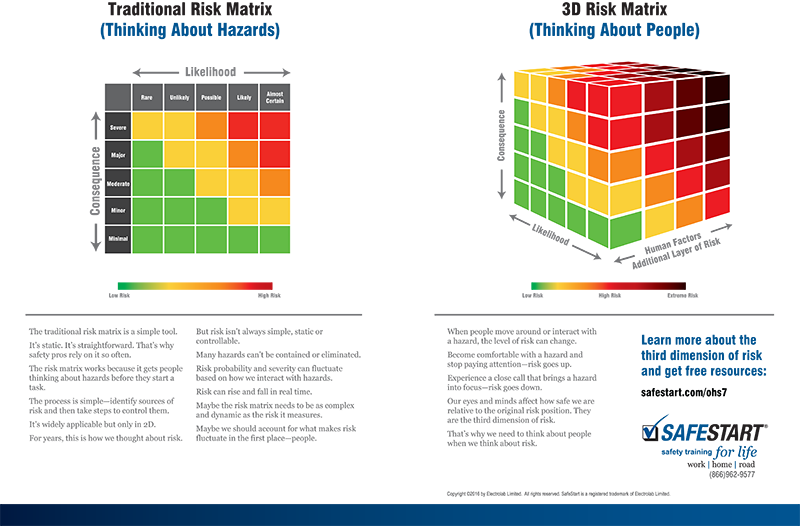If you flipped through the July issue of Occupational Health and Safety magazine, you likely noticed our new “Think About Risk” ad. It’s hard to miss—spanning two full pages and exploding with color.
In case you missed it, here it is.

Everyone at SafeStart spends a lot of time thinking about risk. We do a lot of talking about risk too, with our safety industry specialists speaking to tens of thousands of EHS professionals every year.
One of the most frequent things we hear is about how much risk fluctuates… and how ill-equipped some workers are to adjust their behavior accordingly.
The traditional risk matrix, which you can see on the left-hand side of the ad, is easy to use and does a great job of evaluating risk at the beginning of a job.
But one of the things it doesn’t do quite so well is account for the way that risk rises and falls in real time. For example, the work environment can change in any number of ways throughout the day:
- new hazards can appear in the form of new work equipment or changes to the landscape
- the pace of production gets faster to meet deadlines
- workers get comfortable with hazards and start to feel like they’re bulletproof
- workers get tired and become more likely to make a mistake
Any one of these scenarios (plus countless others) can elevate the risk of an injury. For folks who think about safety all day, it’s not hard to see. Seasoned safety professionals can even anticipate these issues before they happen and then take steps to prevent or mitigate them.
But employees are much less in tune with the shifting tides of risk.
They expect to show up to work every day, do their job and then go home to their families. If a risk matrix is used at the start of their shift, employees are likely to think that level of risk will remain constant.
Now take a look at the right side of the ad. It shows a much more complicated—but realistic—depiction of how risk works.
It’s messy. It might not even be practical to use. But it’s an apt depiction of the multifaceted nature of risk.
Risk can be a lot like a Rubix Cube: try to address one side of it and everything else shifts around it. That’s why a comprehensive solution is necessary—because every side of risk needs to be considered at the same time. And it needs to be considered in real time too.
As the 3D risk diagram demonstrates, there’s no tool or matrix that can easily and accurately forecast risk.
The only practical solution is to provide workers with the skills and awareness to evaluate risk for themselves—so they can recognize when hazards have changed or their state of mind is more likely to lead to an injury.
And in the meantime, don’t abandon the risk matrix—but keep in mind that by the time you’ve completed it and people begin to work, the overall level of risk has already changed.
